By Ben Kitchener, Emilie Ens, Yirralka Rangers and Numbirindi Rangers
As the 2017-2018 wet season drew to a close, Macquarie Univeristy ecologists travelled to the communities of Numbulwar and Yirrkala, and with the local Numbirindi and Yirralka Rangers and Traditional Owners, began the first surveys of this two-year project. This project involves cross-cultural assessment of the biodiversity of remote eastern Arnhem Land. It continues on from a previous joint survey run by the Yugul Mangi, Yirralka and Numbirindi Rangers and Macquarie University which was highlighted in a past ALA blog Sharing Indigenous women’s knowledge of biodiversity and culture across tribal boundaries in Arnhem Land. It also builds on the Ngukurr team’s success as the 2017 Eureka Prize winner for Innovation in Citizen Science.
Our surveys combine western science and technologies with the intricate local Indigenous knowledge of country. They also involve community participation through every aspect of the project, including planning, data collection, data analysis, recording data with the ALA and the communication of project outcomes.
Surveys sites and trapping techniques
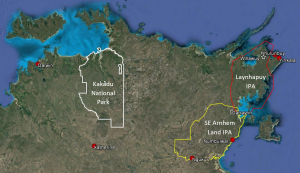
The first surveys during April and May involved 26 community members and rangers. The first survey was conducted at the remote rocky area of Willawuy in the Laynhapuy IPA with the Yirralka Rangers. Following this survey, Macquarie University ecologist Ben Kitchener joined the Numbirindi Rangers and conducted a survey at Garrayrin, along the banks of Walker River in the South-East Arnhem Land IPA (see map and images above). These locations were seen as potential refuges for fauna, especially small mammals, that in recent years have declined in numbers due to invasive species such as cats and Cane Toads.
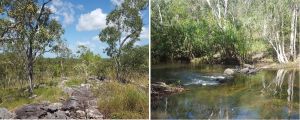
Data collection involved animal trapping using a variety of traps and survey techniques following a modified Northern Territory government standard survey design. We used cage, Elliot, pitfall, funnel and motion-sensor camera traps, along with bird and fish surveys, spotlighting and opportunistic sightings and collections. The survey team also recorded Indigenous knowledge of local plants and animals, including their uses and distributions, as well as stories of the surrounding country.
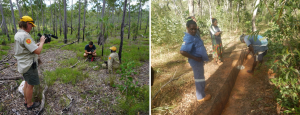
Results: some great finds and fewer pests than expected
These surveys produced some great finds. Although no small mammals were detected at the first survey at Willawuy, there was a variety of reptile and bird species, and very few pests – only three Cane Toads! There was no evidence of pigs or buffalo at all, which is rare for the Top End. We found fewer species at Garrayrin, but excitingly we did find a Grassland Melomys (Melomys burtoni), locally known as Lhudiny, and a Black-headed Monitor (Varanus tristis). The presence of such Monitors is important, particularly as larger Monitors have declined so dramatically with the spread of Cane Toads.
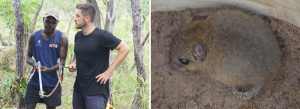
The Willawuy trip saw the introduction of genetic analyses through tissue sample collection from captured animals, with Macquarie’s Ben Kitchener guiding rangers through the process. This will provide the survey team with greater information on regional variation and connectedness within species of eastern Arnhem Land, as well as potentially, the detection of new species.
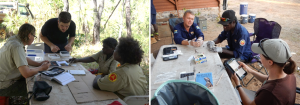
Next steps for Arnhem Land citizen science survey project
The Willawuy survey also provided an opportunity for the Yirralka Rangers to develop a survey video to be used as an education resource. This documented the trip and all survey and cultural activities conducted. The video will give school children and the wider community an exciting look into some of the work rangers do, as well as the value of cross-cultural interactions between external organisations and remote communities.
These survey trips were deemed a great success and a valuable learning experience for all involved with scientific and Indigenous knowledge shared – a perfect way to kick off the two-year Citizen Science Grant project. With the continuation of this project we hope to broaden our understanding of these remote areas, inform local land management and promote the benefits of combining scientific and Indigenous knowledge systems.
For more information about this project, please contact Emilie Ens (emilie.ens@mq.edu.au) .
For more information about the ALA’s Indigenous Ecological Knowledge program, please contact Nat Raisbeck-Brown (Nat.Raisbeck-Brown@csiro.au) or follow these links: